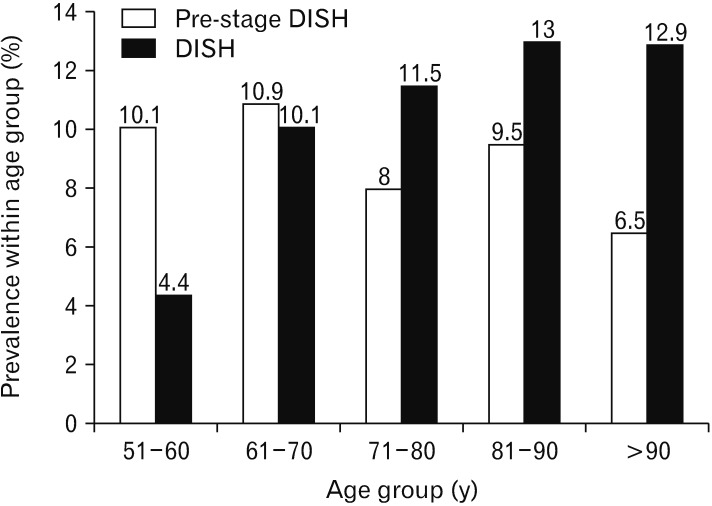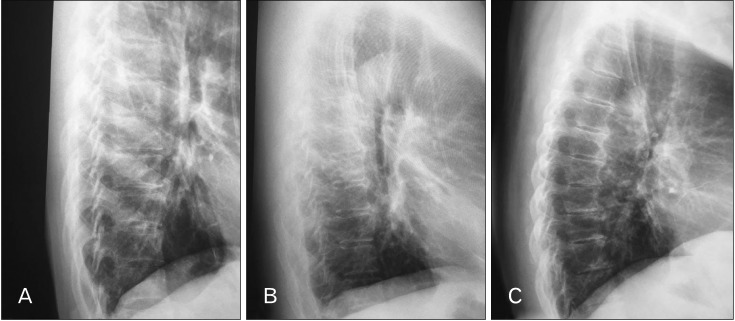1. Forestier J, Rotes-Querol J. Senile ankylosing hyperostosis of the spine. Ann Rheum Dis. 1950; 9:321–330. PMID:
14800245.
2. Resnick D, Shaul SR, Robins JM. Diffuse idiopathic skeletal hyperostosis (DISH): Forestier's disease with extraspinal manifestations. Radiology. 1975; 115:513–524. PMID:
1129458.
3. Nascimento FA, Gatto LA, Lages RO, Neto HM, Demartini Z, Koppe GL. Diffuse idiopathic skeletal hyperostosis: a review. Surg Neurol Int. 2014; 5(Suppl 3):S122–S125. PMID:
24843807.
4. Mata S, Fortin PR, Fitzcharles MA, Starr MR, Joseph L, Watts CS, Gore B, Rosenberg E, Chhem RK, Esdaile JM. A controlled study of diffuse idiopathic skeletal hyperostosis: clinical features and functional status. Medicine (Baltimore). 1997; 76:104–117. PMID:
9100738.
5. Nelson RS, Urquhart AC, Faciszewski T. Diffuse idiopathic skeletal hyperostosis: a rare cause of dysphagia, airway obstruction, and dysphonia. J Am Coll Surg. 2006; 202:938–942. PMID:
16735209.
6. Caron T, Bransford R, Nguyen Q, Agel J, Chapman J, Bellabarba C. Spine fractures in patients with ankylosing spinal disorders. Spine (Phila Pa 1976). 2010; 35:E458–E464. PMID:
20421858.
7. Mader R. Clinical manifestations of diffuse idiopathic skeletal hyperostosis of the cervical spine. Semin Arthritis Rheum. 2002; 32:130–135. PMID:
12430101.
8. Westerveld LA, Verlaan JJ, Oner FC. Spinal fractures in patients with ankylosing spinal disorders: a systematic review of the literature on treatment, neurological status and complications. Eur Spine J. 2009; 18:145–156. PMID:
18791749.
9. DiGiovanna JJ, Helfgott RK, Gerber LH, Peck GL. Extraspinal tendon and ligament calcification associated with long-term therapy with etretinate. N Engl J Med. 1986; 315:1177–1182. PMID:
3463863.
10. DiGiovanna JJ. Isotretinoin effects on bone. J Am Acad Dermatol. 2001; 45:S176–S182. PMID:
11606950.
11. Moskowitz RW, Boja B, Denko CW. The role of growth factors in degenerative joint disorders. J Rheumatol Suppl. 1991; 27:147–148. PMID:
2027117.
12. Denko CW, Malemud CJ. Body mass index and blood glucose: correlations with serum insulin, growth hormone, and insulin-like growth factor-1 levels in patients with diffuse idiopathic skeletal hyperostosis (DISH). Rheumatol Int. 2006; 26:292–297. PMID:
15703952.
13. Kiss C, Szilágyi M, Paksy A, Poór G. Risk factors for diffuse idiopathic skeletal hyperostosis: a case-control study. Rheumatology (Oxford). 2002; 41:27–30. PMID:
11792876.
14. Troillet N, Gerster JC. Forestier disease and metabolism disorders: a prospective controlled study of 25 cases. Rev Rhum Ed Fr. 1993; 60:274–279. PMID:
8167624.
15. Atzeni F, Sarzi-Puttini P, Bevilacqua M. Calcium deposition and associated chronic diseases (atherosclerosis, diffuse idiopathic skeletal hyperostosis, and others). Rheum Dis Clin North Am. 2006; 32:413–426. PMID:
16716887.
16. Resnick D, Shapiro RF, Wiesner KB, Niwayama G, Utsinger PD, Shaul SR. Diffuse idiopathic skeletal hyperostosis (DISH) [ankylosing hyperostosis of Forestier and Rotes-Querol]. Semin Arthritis Rheum. 1978; 7:153–187. PMID:
341323.
17. Al-Herz A, Snip JP, Clark B, Esdaile JM. Exercise therapy for patients with diffuse idiopathic skeletal hyperostosis. Clin Rheumatol. 2008; 27:207–210. PMID:
17885726.
18. Umerah BC, Mukherjee BK, Ibekwe O. Cervical spondylosis and dysphagia. J Laryngol Otol. 1981; 95:1179–1183. PMID:
7299268.
19. Julkunen H, Heinonen OP, Knekt P, Maatela J. The epidemiology of hyperostosis of the spine together with its symptoms and related mortality in a general population. Scand J Rheumatol. 1975; 4:23–27. PMID:
1153976.
20. Bloom RA. The prevalence of ankylosing hyperostosis in a Jerusalem population: with description of a method of grading the extent of the disease. Scand J Rheumatol. 1984; 13:181–189. PMID:
6740271.
21. Boachie-Adjei O, Bullough PG. Incidence of ankylosing hyperostosis of the spine (Forestier's disease) at autopsy. Spine (Phila Pa 1976). 1987; 12:739–743. PMID:
3500518.
22. Cassim B, Mody GM, Rubin DL. The prevalence of diffuse idiopathic skeletal hyperostosis in African blacks. Br J Rheumatol. 1990; 29:131–132. PMID:
2322769.
23. Weinfeld RM, Olson PN, Maki DD, Griffiths HJ. The prevalence of diffuse idiopathic skeletal hyperostosis (DISH) in two large American Midwest metropolitan hospital populations. Skeletal Radiol. 1997; 26:222–225. PMID:
9151370.
24. Kiss C, O'Neill TW, Mituszova M, Szilágyi M, Poór G. The prevalence of diffuse idiopathic skeletal hyperostosis in a population-based study in Hungary. Scand J Rheumatol. 2002; 31:226–229. PMID:
12369655.
25. Kim SK, Choi BR, Kim CG, Chung SH, Choe JY, Joo KB, Bae SC, Yoo DH, Jun JB. The prevalence of diffuse idiopathic skeletal hyperostosis in Korea. J Rheumatol. 2004; 31:2032–2035. PMID:
15468371.
26. Pappone N, Lubrano E, Esposito-del Puente A, D'Angelo S, Di Girolamo C, Del Puente A. Prevalence of diffuse idiopathic skeletal hyperostosis in a female Italian population. Clin Exp Rheumatol. 2005; 23:123–124. PMID:
15789903.
27. Westerveld LA, van Ufford HM, Verlaan JJ, Oner FC. The prevalence of diffuse idiopathic skeletal hyperostosis in an outpatient population in The Netherlands. J Rheumatol. 2008; 35:1635–1638. PMID:
18528963.
28. Kagotani R, Yoshida M, Muraki S, Oka H, Hashizume H, Yamada H, Enyo Y, Nagata K, Ishimoto Y, Teraguchi M, Tanaka S, Nakamura K, Kawaguchi H, Akune T, Yoshimura N. Prevalence of diffuse idiopathic skeletal hyperostosis (DISH) of the whole spine and its association with lumbar spondylosis and knee osteoarthritis: the ROAD study. J Bone Miner Metab. 2015; 33:221–229. PMID:
24623190.
29. Mori K, Kasahara T, Mimura T, Nishizawa K, Nakamura A, Imai S. Prevalence of thoracic diffuse idiopathic skeletal hyperostosis (DISH) in Japanese: Results of chest CT-based cross-sectional study. J Orthop Sci. 2017; 22:38–42. PMID:
27697426.
31. Meyer M, Forester E. Considerations pathogeniques sur l'hyperostose moniliforme du flanc droit de la colonne dorsale. Rev Rhum Mal Osteoartic. 1938; 5:286–293.
32. Utsinger PD. Diffuse idiopathic skeletal hyperostosis. Clin Rheum Dis. 1985; 11:325–351. PMID:
3899489.
33. Cammisa M, De Serio A, Guglielmi G. Diffuse idiopathic skeletal hyperostosis. Eur J Radiol. 1998; 27(Suppl 1):S7–S11. PMID:
9652495.
34. Strickland NH. PACS (picture archiving and communication systems): filmless radiology. Arch Dis Child. 2000; 83:82–86. PMID:
10869010.
35. Mata S, Hill RO, Joseph L, Kaplan P, Dussault R, Watts CS, Fitzcharles MA, Shiroky JB, Fortin PR, Esdaile JM. Chest radiographs as a screening test for diffuse idiopathic skeletal hyperostosis. J Rheumatol. 1993; 20:1905–1910. PMID:
8308777.
36. Holton KF, Denard PJ, Yoo JU, Kado DM, Barrett-Connor E, Marshall LM. Osteoporotic Fractures in Men (MrOS) Study. Diffuse idiopathic skeletal hyperostosis and its relation to back pain among older men: the MrOS Study. Semin Arthritis Rheum. 2011; 41:131–138. PMID:
21377195.
37. Henrard JC, Bennett PH. Epidemiological study of vertebral hyperostosis. Survey in an adult population of American Indians. Rev Rhum Mal Osteoartic. 1973; 40:581–591. PMID:
4767882.







 PDF
PDF ePub
ePub Citation
Citation Print
Print




 XML Download
XML Download